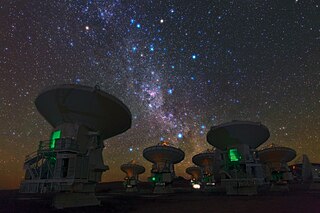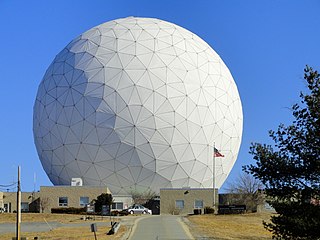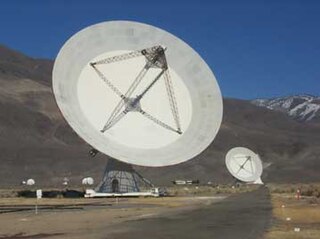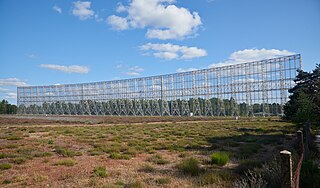
A radio telescope is a specialized antenna and radio receiver used to detect radio waves from astronomical radio sources in the sky. Radio telescopes are the main observing instrument used in radio astronomy, which studies the radio frequency portion of the electromagnetic spectrum emitted by astronomical objects, just as optical telescopes are the main observing instrument used in traditional optical astronomy which studies the light wave portion of the spectrum coming from astronomical objects. Unlike optical telescopes, radio telescopes can be used in the daytime as well as at night.

Radio astronomy is a subfield of astronomy that studies celestial objects at radio frequencies. The first detection of radio waves from an astronomical object was in 1933, when Karl Jansky at Bell Telephone Laboratories reported radiation coming from the Milky Way. Subsequent observations have identified a number of different sources of radio emission. These include stars and galaxies, as well as entirely new classes of objects, such as radio galaxies, quasars, pulsars, and masers. The discovery of the cosmic microwave background radiation, regarded as evidence for the Big Bang theory, was made through radio astronomy.

Very-long-baseline interferometry (VLBI) is a type of astronomical interferometry used in radio astronomy. In VLBI a signal from an astronomical radio source, such as a quasar, is collected at multiple radio telescopes on Earth or in space. The distance between the radio telescopes is then calculated using the time difference between the arrivals of the radio signal at different telescopes. This allows observations of an object that are made simultaneously by many radio telescopes to be combined, emulating a telescope with a size equal to the maximum separation between the telescopes.

The 22-metre Mopra Radio Telescope, located near Coonabarabran, New South Wales, is part of the Australia Telescope National Facility, operated by CSIRO. The name hails from the location of the facility close to Mopra Rock a geological formation overlooking the telescope. It is also close to the Siding Spring optical observatory in the Warrumbungle National Park.

Owens Valley Radio Observatory (OVRO) is a radio astronomy observatory located near Big Pine, California (US) in Owens Valley. It lies east of the Sierra Nevada, approximately 350 kilometers (220 mi) north of Los Angeles and 20 kilometers (12 mi) southeast of Bishop. It was established in 1956, and is owned and operated by the California Institute of Technology (Caltech). The Owens Valley Solar Array portion of the observatory has been operated by New Jersey Institute of Technology (NJIT) since 1997.

The Mount Pleasant Radio Observatory is a radio astronomy based observatory owned and operated by University of Tasmania, located 20 km east of Hobart in Cambridge, Tasmania. It is home to three radio astronomy antennas and the Grote Reber Museum.

The Atacama Pathfinder Experiment (APEX) is a radio telescope 5,064 meters above sea level, at the Llano de Chajnantor Observatory in the Atacama desert in northern Chile, 50 km east of San Pedro de Atacama built and operated by 3 European research institutes. The main dish has a diameter of 12 m and consists of 264 aluminium panels with an average surface accuracy of 17 micrometres (rms). The telescope was officially inaugurated on September 25, 2005.

Haystack Observatory is a multidisciplinary radio science center, ionospheric observatory, and astronomical microwave observatory owned by Massachusetts Institute of Technology (MIT). It is located in Westford, Massachusetts (US), approximately 45 kilometers (28 mi) northwest of Boston. Haystack was initially built by MIT's Lincoln Laboratory for the United States Air Force and was known as Haystack Microwave Research Facility. Construction began in 1960, and the antenna began operating in 1964. In 1970 the facility was transferred to MIT, which then formed the Northeast Radio Observatory Corporation (NEROC) with a number of other universities to operate the site as the Haystack Observatory. As of January 2012, a total of nine institutions participated in NEROC.

The Dominion Radio Astrophysical Observatory is a research facility founded in 1960 and located at Kaleden, British Columbia, Canada. The site houses four radio telescopes: an interferometric radio telescope, a 26-m single-dish antenna, a solar flux monitor, and the Canadian Hydrogen Intensity Mapping Experiment (CHIME) — as well as support engineering laboratories. The DRAO is operated by the Herzberg Institute of Astrophysics of the National Research Council of the Government of Canada. The observatory was named an IEEE Milestone for first radio astronomical observations using VLBI.

The Medicina Radio Observatory is an astronomical observatory located 30 km from Bologna, Italy. It is operated by the Institute for Radio Astronomy of the National Institute for Astrophysics (INAF) of the government of Italy.

The NRC Herzberg Astronomy and Astrophysics Research Centre, formerly the NRC Herzberg Institute of Astrophysics (NRC-HIA), is the leading Canadian centre for astronomy and astrophysics.

A telescope is an optical instrument using lenses, curved mirrors, or a combination of both to observe distant objects, or various devices used to observe distant objects by their emission, absorption, or reflection of electromagnetic radiation. The first known practical telescopes were refracting telescopes invented in the Netherlands at the beginning of the 17th century, by using glass lenses. They were used for both terrestrial applications and astronomy.

The ARO 12m Radio Telescope is a 12-meter dish located on Kitt Peak, approximately 60 mi (100 km) from Tucson in Arizona at an elevation of 6215.8 ft.
Arthur Edwin Covington was a Canadian physicist who made the first radio astronomy measurements in Canada. Through these he made the valuable discovery that sunspots generate large amounts of microwaves at the 10.7 cm wavelength, offering a simple all-weather method to measure and predict sunspot activity, and their associated effects on communications. The sunspot detection program has run continuously to this day.

Okanagan Falls is a community located on the south end of Skaha Lake in British Columbia.

The Owens Valley Solar Array (OVSA), also known as Expanded Owens Valley Solar Array (EOVSA), is an astronomical radio telescope array, located at Owens Valley Radio Observatory (OVRO), near Big Pine, California, with main interests in studying the physics of the Sun. The instruments of the observatory are designed and employed specifically for studying the activities and phenomena of our solar system's sun. Other solar dedicated instruments operated on the site include the Solar Radio Burst Locator (SRBL), the FASR Subsystem Testbed (FST), and the Korean SRBL (KSRBL). The OVSA is operated by the New Jersey Institute of Technology (NJIT), which also operates the Big Bear Solar Observatory.

Northern Light was a concept mission for a robotic mission to Mars that would consist of a lander and a rover, being studied by a consortium of Canadian universities, companies and organisations. The primary contractor for the spacecraft was Thoth Technology Inc.

The Large Latin American Millimeter Array (LLAMA) is a single-dish 12 m Nasmyth optics antenna which is under construction in the Puna de Atacama desert in the Province of Salta, Argentina. The primary mirror accuracy will allow observation from 40 GHz up to 900 GHz. It is also planned to install a bolometer camera at millimeter wavelengths. After installation it will be able to join other similar instruments to perform Very Large Base Line Interferometry or to work in standalone mode. Financial support is provided by the Argentinian and Brazilian governments. The total cost of construction, around US$20 million, and operation as well as the telescope time use will be shared equally by the two countries. Construction planning started in July 2014 after the formal signature of an agreement between the main institutions involved.

The Algonquin 46m radio telescope (ARO) is a radio telescope at the Algonquin Radio Observatory, Canada. This radio telescope is historically famous for taking part in the first successful very long baseline interferometry experiment in the 1960s, where it was experimentally arrayed with the 26-metre Telescope at the Dominion Radio Astrophysical Observatory near Penticton, British Columbia.

The Nançay Radio Observatory, opened in 1956, is part of Paris Observatory, and also associated with the University of Orléans. It is located in the department of Cher in the Sologne region of France. The station consists of several instruments. Most iconic of these is the large decimetric radio telescope, which is one of the largest radio telescopes in the world. Long established are also the radio heliograph, a T-shaped array, and the decametric array operating at wavelengths between 3 m and 30 m.






















